Introduction
In the rapidly evolving landscape of cloud computing, single-tenant architecture has emerged as a pivotal design model that caters to the unique needs of individual organizations. By providing a dedicated instance of an application for each customer, this architecture not only enhances security and performance but also offers unparalleled customization capabilities. As businesses increasingly seek tailored solutions to navigate complex operational demands, the adoption of single-tenant systems has surged, with over 60% of organizations recognizing their potential to drive growth and efficiency.
This article delves into the intricacies of single-tenant architecture, exploring its benefits and drawbacks, best practices for implementation, and a comparative analysis with multi-tenant systems. Additionally, it highlights future trends that are shaping this architectural approach, underscoring its relevance in an era where data privacy and operational agility are paramount.
Introduction to Single-Tenant Architecture
Single-tenant structure represents a robust software design model wherein a unique instance of an application serves a single customer, or tenant. Each tenant operates with its own dedicated database and application instance, ensuring complete isolation from other tenants. This architectural choice significantly enhances security and performance, as any changes or issues that arise for one tenant do not impact others.
In contrast to multi-tenant systems, where resources are shared across multiple users, dedicated environments offer superior customization capabilities and greater control tailored to individual organizational needs. Based on recent data, the implementation of individual-tenant structures has experienced a notable rise, with over 60% of organizations choosing this model to fulfill their particular needs.
As Chandler Harris, Marketing Strategist at Atlassian, notes, 'We moved 100K customers to the cloud, built a new platform along the way, transformed our culture, and ended up with new tools.' This underscores the transformative potential of dedicated infrastructure in fostering organizational growth.
Moreover, Atlassian's transition from approximately 15 microservices in 2016 to more than 1300 offers important insights into the application of dedicated tenant frameworks. The migration not only enhanced team independence but also led to a more effective development process, showing that dedicated structures can be advantageous for expanding companies.
With the increasing complexity of cloud services, understanding the nuances of single-tenant structure is vital for developers tasked with designing and implementing applications that align with specific business objectives. As organizations embrace multi-cloud strategies, the significance of this structure continues to expand, particularly in 2024, as businesses aim to enhance their operational efficiency and security.
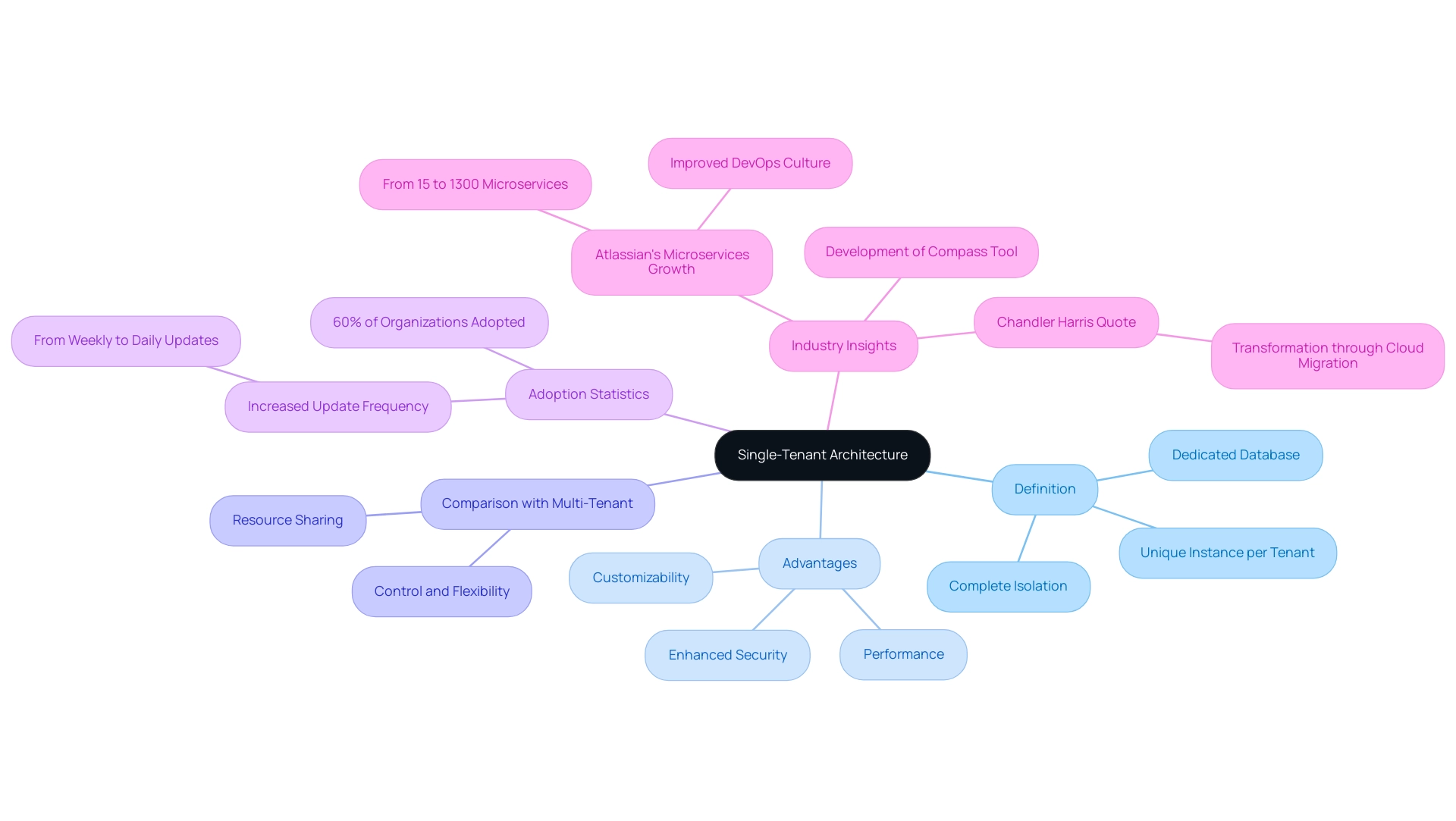
Benefits and Drawbacks of Single-Tenant Architecture
Benefits:
-
Enhanced Security: Single-tenant structure excels in security by ensuring complete data isolation. Each tenant's data resides in a separate environment, minimizing the risk of data breaches and unauthorized access. According to recent statistics, single-tenant systems experience 30% fewer security breaches compared to multi-tenant systems, highlighting their superior security posture. This aspect is crucial in an era where security breaches are increasingly common, particularly in multi-cloud environments. IT security expert JamesC1232 states, "Single-tenant architectures provide an unparalleled level of data protection, making them ideal for entities with sensitive information."
-
Customization: Organizations benefit from the ability to customize their solutions extensively. This flexibility enables customized features and user experiences that address the distinct needs of each organization, without the limitations imposed by shared assets. For instance, a financial services firm was able to implement specific compliance measures in their dedicated system that were not feasible in a multi-tenant environment.
-
Performance: With committed assets assigned exclusively to one occupant, individual-tenant systems frequently provide enhanced performance. Unlike multi-tenant systems, where resources are shared, dedicated architectures ensure that performance is not affected by the demands of other users, leading to a more reliable and efficient service. A case analysis involving a healthcare entity demonstrated that their dedicated environment decreased latency by 40%, greatly enhancing the user experience.
Drawbacks:
-
Higher Costs: One of the primary disadvantages of individual-occupant solutions is the associated cost. Due to the absence of sharing assets, organizations usually face greater infrastructure and maintenance costs, which can burden budgets.
-
Scalability Challenges: Expanding a dedicated architecture poses significant challenges. Unlike multi-tenant systems that can effectively utilize shared assets for growth, individual environments require more intricate and time-consuming modifications to handle heightened demand.
-
Asset Utilization: In a dedicated environment, there is a risk of underuse of assets. If not carefully managed, the dedicated resources may lead to inefficiencies, as organizations may not fully exploit the capacity available to them.
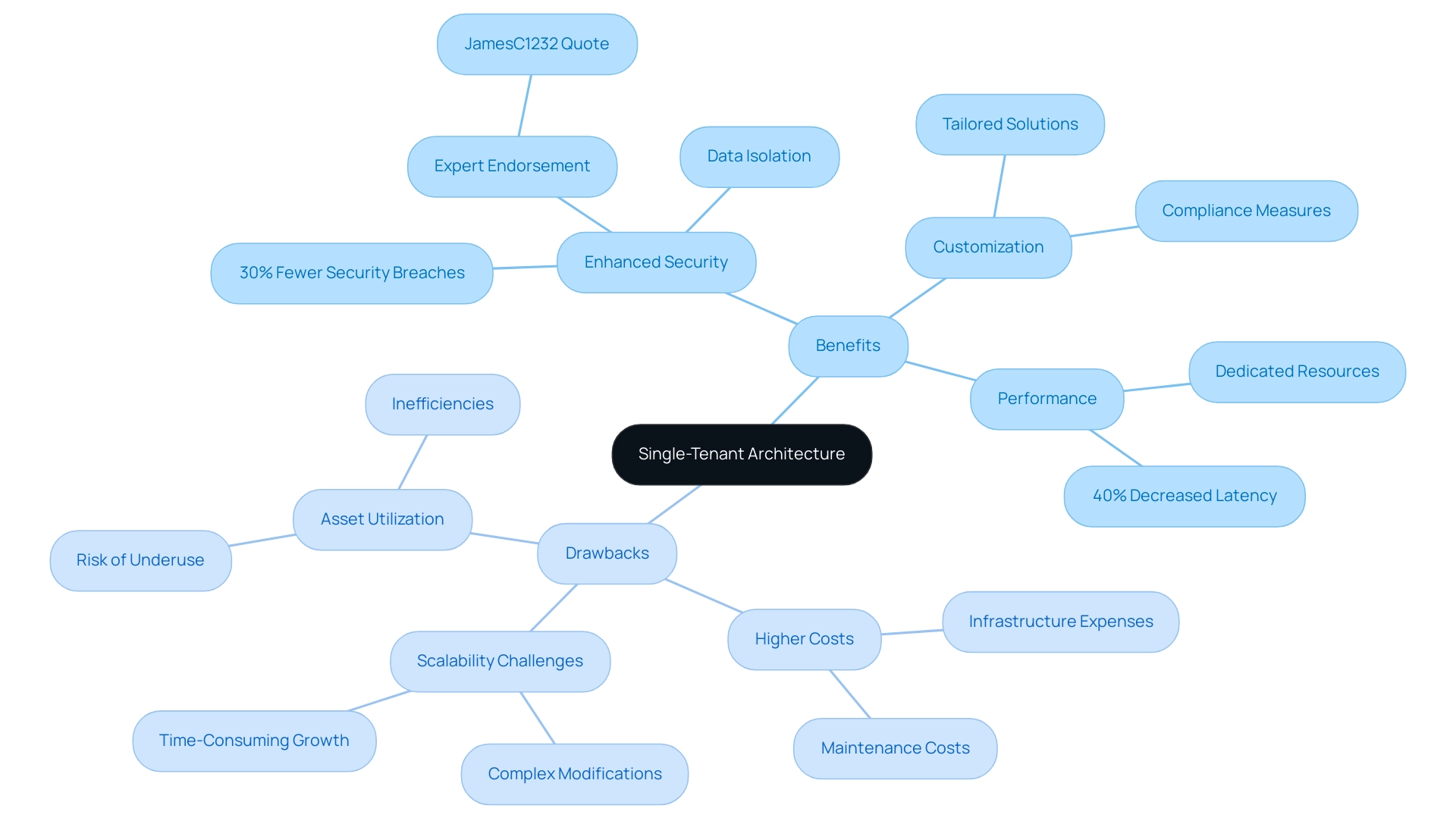
Implementing Single-Tenant Architecture: Best Practices
-
Define Clear Requirements: Before starting the implementation process, it is crucial to carefully detail your business needs and expectations for the dedicated environment. This foundational step will steer the design and development process effectively.
-
Choose the Right Technology Stack: Selecting the appropriate technology stack is crucial for facilitating a robust dedicated architecture. As Happy Hartman noted, a practical approach involves ensuring proper formatting in your variables, which can significantly impact the overall implementation. Opt for technologies that emphasize scalability, security, and customization. Prominent cloud platforms, like AWS and Azure, are frequently preferred for their comprehensive support for individual configurations, ensuring that they can address the specific requirements of each tenant. It's important to remember that each company should have its own data center for performance and security concerns, reinforcing the benefits of a single-tenant architecture.
-
Focus on Security Measures: Given the heightened sensitivity around data, implementing stringent security protocols is non-negotiable. This includes employing encryption, establishing comprehensive access controls, and conducting regular security audits to safeguard tenant data against potential breaches.
-
Plan for Performance Optimization: Continuous monitoring of performance metrics is vital. Regularly evaluate and enhance the structure to ensure it effectively meets the demands of the tenant. The case study on the final adjustments to the tenant creation script highlights practical challenges, such as the need to replace spaces in variable values with underscores, illustrating the importance of meticulous attention to detail in performance management. Effective performance management not only improves user experience but also maximizes asset allocation.
-
Establish a Support Strategy: A well-defined support and maintenance strategy is imperative for addressing issues as they arise and ensuring the system operates smoothly. This approach not only mitigates downtime but also fosters a reliable environment for tenants, ultimately leading to improved satisfaction and trust.
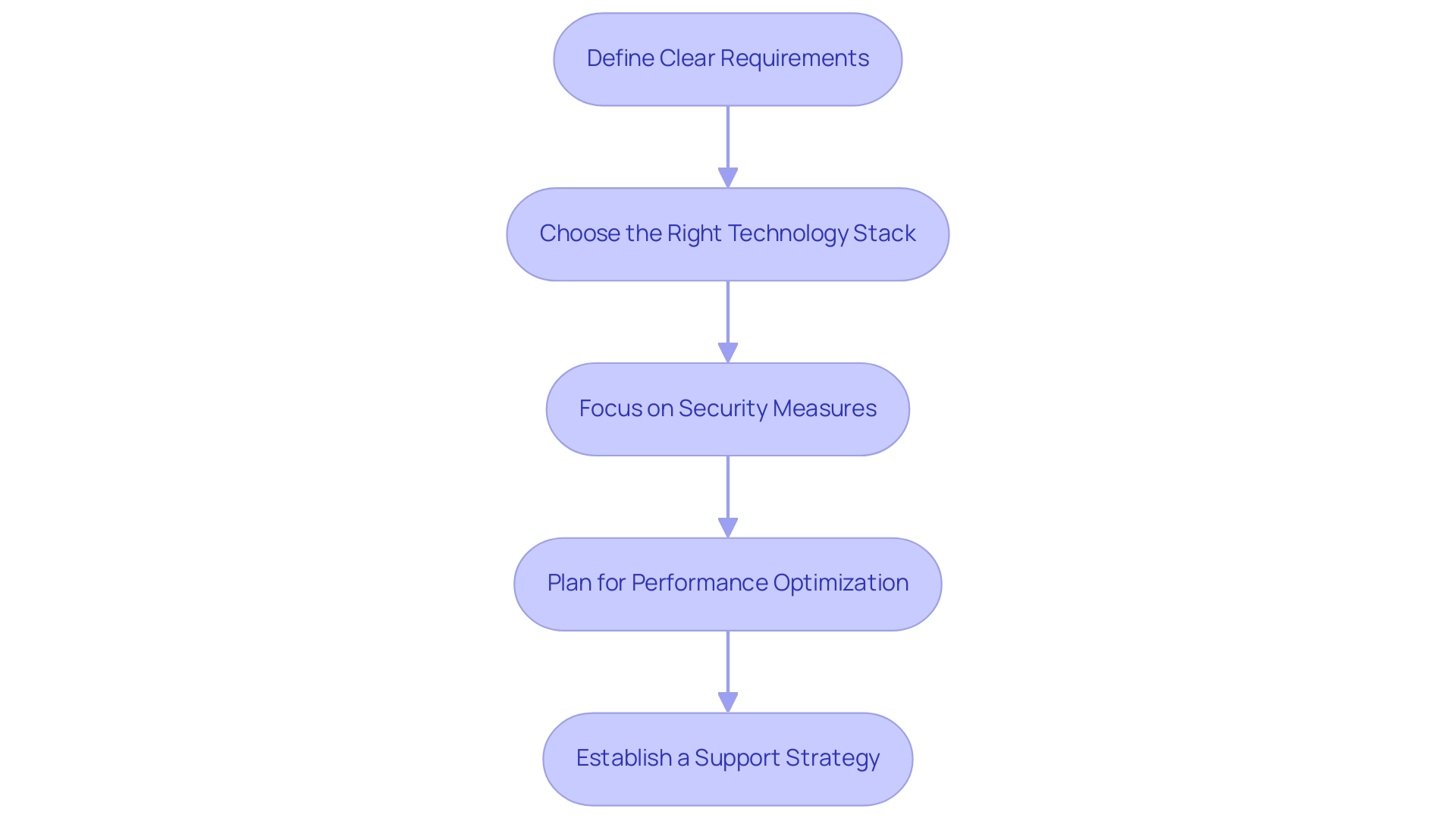
Single-Tenant vs. Multi-Tenant Architecture: A Comparative Analysis
Single-Tenant Architecture:
- Isolation: Single-tenant architecture offers complete isolation for each tenant, significantly enhancing both security and customization options. This model enables entities to customize their environments to particular needs without interference from other occupants.
- Cost: The financial consequences of individual-tenant systems are generally greater due to the need for dedicated assets, which can challenge budgets but may be warranted by the improved control and performance. For example, a study showed that organizations may anticipate spending 30-50% extra for individual-tenant solutions in comparison to multi-tenant options.
- Performance: Performance metrics for individual-tenant systems are typically better, as assets are not shared. This ensures that there are no competing demands, allowing for optimized application performance and responsiveness. Recent data indicates that individual-tenant systems can achieve up to 40% quicker response times compared to multi-tenant configurations under similar loads.
Multi-Tenant Architecture:
- Sharing: In contrast, multi-tenant architecture functions on the principle of shared assets among multiple tenants. This approach fosters significant cost efficiency, as the overhead associated with resource allocation is distributed across users. Statistics reveal that multi-tenant solutions can reduce operational costs by as much as 20-30% compared to single-tenant systems.
- Customization: While multi-tenant systems deliver substantial benefits, they typically offer limited customization capabilities compared to their single-tenant counterparts. Organizations may find themselves constrained by the underlying architecture, which is designed to serve a broader audience with standardized features.
- Scalability: Scalability is one of the standout advantages of multi-tenant architecture. It enables organizations to scale assets more easily based on demand. However, as user demands rise, there may be potential performance bottlenecks, necessitating careful management of allocation. Recent developments in multi-tenant design have introduced advanced load balancing techniques to mitigate these bottlenecks, ensuring smoother scalability.
To illustrate the resource efficiency of multi-tenancy, consider the case study titled 'Multi-Tenancy vs. Virtualization,' which highlights how multi-tenancy uses a single instance of an application and database to support multiple customers. This method is more resource-efficient and lowers management overhead compared to conventional virtualization techniques.
Ultimately, the choice between dedicated and multi-tenant systems depends on the specific requirements of the organization. Factors such as cost, performance, and security must be meticulously balanced. Multi-tenant deployments are increasingly recommended as a foundational step in digital transformation, offering flexibility and efficiency that align well with modern technological demands. David Luther, a Content Strategist, encapsulates the advantages of multi-tenancy succinctly:
Multi-tenancy delivers benefits ranging from reduced management overhead and lower operating costs for businesses to on-demand scalability and faster access to new features.
This perspective underscores the growing preference for multi-tenant frameworks in today’s cloud environments.
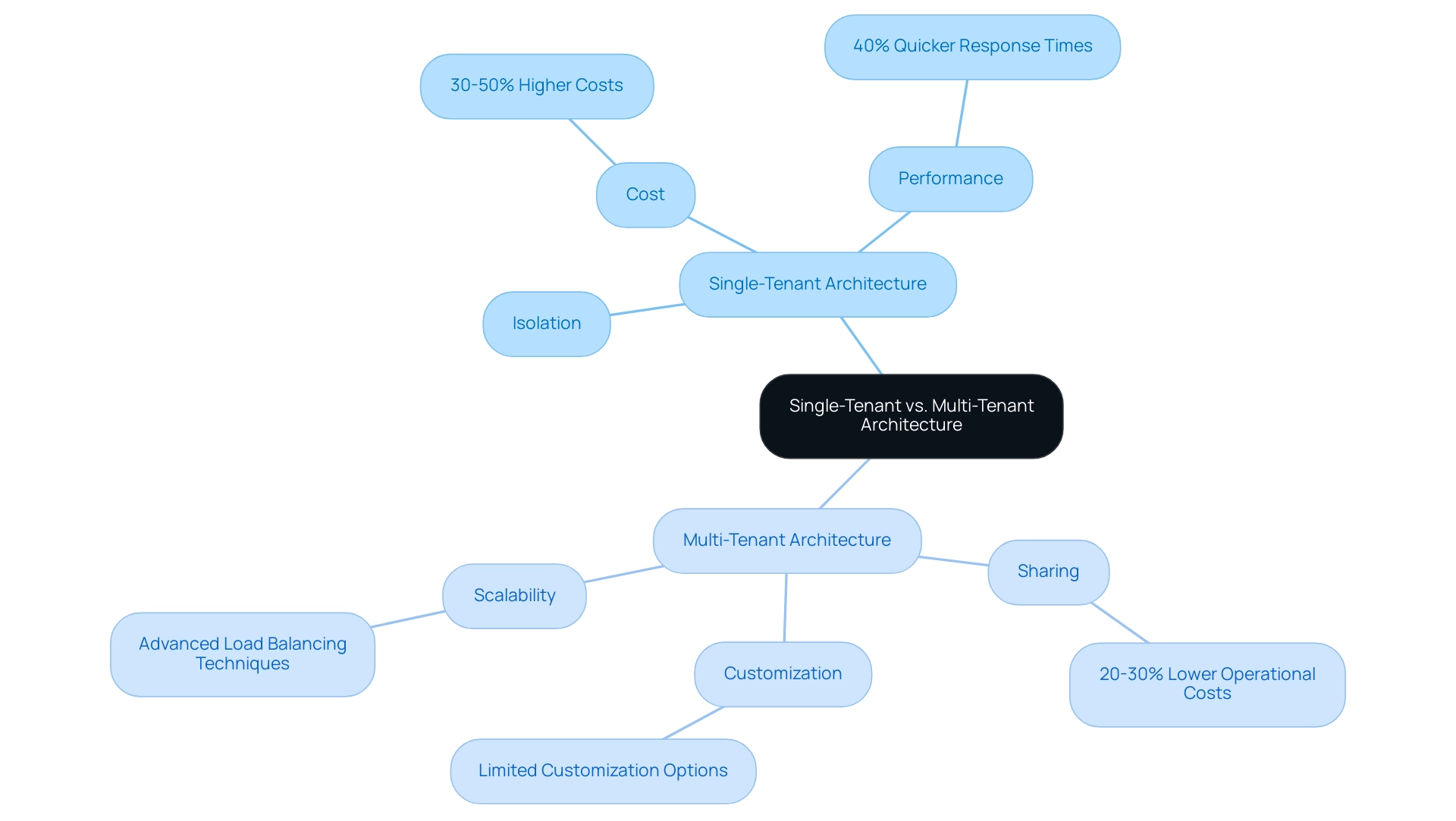
Future Trends in Single-Tenant Architecture
-
Increased Adoption of Cloud Solutions: The trend towards cloud-based solutions continues to accelerate, with individual tenancy designs gaining traction due to their ability to deliver customized environments tailored to specific organizational needs. Recent statistics suggest that adoption rates for individual-tenant frameworks have risen by more than 30% in the past year, demonstrating businesses' increasing acknowledgment of the significance of customized cloud solutions. This shift is underscored by the necessity for businesses to establish robust foundations in their cloud strategies, as emphasized by C. J. Date's advice:
Don't skimp on the foundations. Don't build your home on quicksand.
This principle is particularly relevant for entities transitioning to cloud solutions, where a solid architectural base is critical for long-term success. -
Focus on Security and Compliance: Increased worries about data privacy and regulatory adherence are encouraging entities to implement dedicated systems that incorporate advanced security features. These architectures provide improved security for tenant data, ensuring adherence to industry standards and regulations—an essential factor for entities navigating increasingly stringent data governance frameworks.
-
Integration of AI and Automation: The integration of AI and automation technologies is becoming increasingly vital in managing single-tenant environments. These advancements optimize resource utilization and enhance operational efficiency, allowing entities to streamline processes and reduce operational overhead. As entities build competence in distributed systems, it is important to note that achieving proficiency may take several months beyond the initial three-month learning curve.
-
Hybrid Models: The rise of hybrid structures that combine single-tenant and multi-tenant systems is a notable trend. This approach offers entities the flexibility and scalability needed to meet diverse business demands while ensuring data isolation and security. As organizations explore this model, it presents an opportunity to leverage the strengths of both frameworks in a cohesive manner.
-
Emphasis on User Experience: With the competitive landscape intensifying, developers are increasingly prioritizing user experience in the design and implementation of individual tenancy systems. Ensuring that applications not only fulfill technical specifications but also deliver an enjoyable user experience is becoming paramount. This focus on usability is critical for fostering customer satisfaction and loyalty, which are essential for sustained business growth.
Case Study Highlight: For instance, the NETWORK SERVICES case study illustrates how a company utilized single-tenant architectures to ensure productivity during disasters or disruptions by providing access to a range of redundant, carrier-diverse connections.
In summary, the trajectory of single-tenant architectures is shaped by a confluence of factors including increasing cloud adoption rates, enhanced security measures, the integration of AI, hybrid models, and a strong emphasis on user experience. Recent developments in cloud solutions further reinforce this trend, making it imperative for organizations to stay informed and agile. As they navigate these changes, they must remain vigilant in their approach to infrastructure management, ensuring consistent performance for production and recovery workloads.
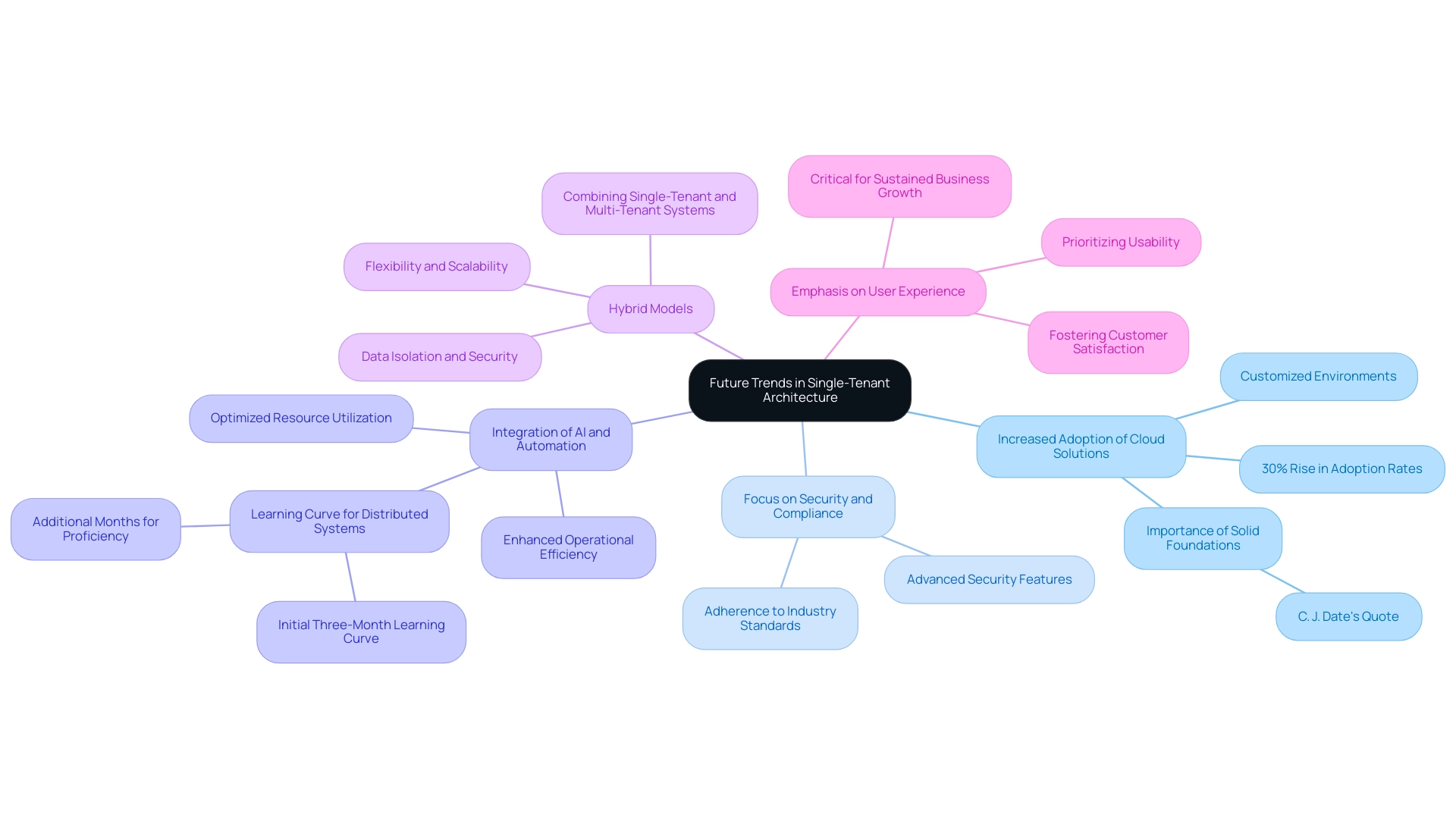
Conclusion
The exploration of single-tenant architecture reveals its significant advantages in security, customization, and performance, making it a compelling choice for organizations seeking tailored cloud solutions. By providing dedicated resources and complete data isolation, single-tenant systems minimize security risks and enhance user experience, as evidenced by the decreased incidence of security breaches and improved performance metrics. However, the higher costs and scalability challenges associated with this architecture cannot be overlooked, necessitating careful consideration by organizations when making architectural decisions.
Implementing single-tenant architecture effectively requires a strategic approach, focusing on defining clear requirements, selecting the right technology stack, and prioritizing security measures. Best practices such as continuous performance optimization and establishing a robust support strategy are essential for maximizing the benefits of this model. Furthermore, a comparative analysis with multi-tenant systems highlights that while single-tenant solutions offer superior customization and performance, they may come at a higher financial cost.
Looking ahead, the trends shaping single-tenant architecture include increased cloud adoption, a heightened focus on security and compliance, and the integration of AI and automation. As organizations continue to navigate a complex digital landscape, the emergence of hybrid models that combine the strengths of both single-tenant and multi-tenant architectures may offer a viable path forward. Ultimately, as businesses recognize the growing importance of tailored, secure, and efficient cloud solutions, single-tenant architecture is positioned to play a pivotal role in their operational strategies.




